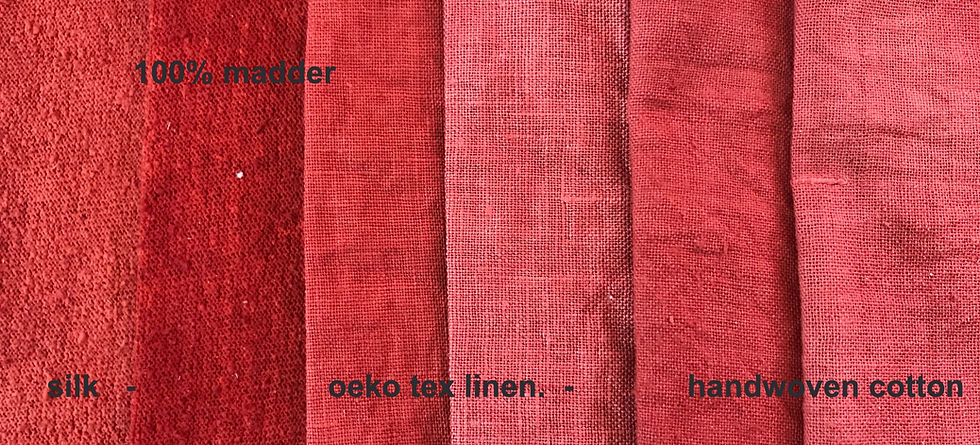Dyeing with Madder (Rubia Tinctorum)
- Suzanne Dekel
- Nov 17, 2021
- 4 min read
Updated: Mar 11, 2023

Rubia Tinctoria, the famous red dye from the anthraquinone family. Choosing the right Weight Of Fiber (WOF) and the right mordant is crucial for getting the perfect reds (as is choosing the right madder. Many of you struggle with getting the right shades and the most common complaint is that the shades come out too orange, or too pink. Today I will show you how to get the best deep reds, consistently.
If you have not done it yet, I recommend reading this blog about the fascinating history of madder in the Netherlands.
Madder is divided in grades. The higher the grade, the more alizarin content it has, which is the red phytopigment we need. The alizarin develops in the roots of the madder plant and is at its' best after at least three years in the field. The standard of grades is universal wether your madder was grown in Europe or in other parts of the world.
There is second, first and Premium grade madder and then there is the madder extract. You can recognize Premium madder by the shade of the powder, it is lighter, and more orang-y because it is made from stripped root. Second grade madder is more brown, because it is ground with the bark of the root together. Currently we have organic Premium grade and extract on the website.
For the samples used, I only used Premium grade madder that I run on the website, as it has the highest alizarin content. In the future I will run a gamut of madder extract with different WOF's for you.
Madder Trivia: Second grade madder is used today mainly for use in fish and pet food as a natural colourant.
Mordants, or tannins, or both?
Choosing the right base to create a fast dye depends much on the fibre content, as you will see soon in the samples.
I choose three fabrics: silk noil, oeko tex linen and handwoven cotton. The samples were divided in two. The first group was put in a cold 2% aluminium triformate solution according to the recipe, for three days. The second group was mordanted cold with a four day process of alum, oak gall, alum and again oak gall.
Reade more about aluminiumtriformate here; https://www.suzannedekel.com/post/all-about-alum-based-mordants
The dye:
After rinsing and drying all the samples were marked with a black permanent marker so it was easy to recognize which was which. All. samples were divided in three groups and weighed again (dry).
The madder powder from the website is extremely well ground, so use a mask to avoid inhaling the dust. There is no need to soak the powder in cold water overnight, as I would have done with roots bits.
Bath one: 25% WOF Premium Madder
Bath two: 50% WOF Premium Madder
Bath three: 100% WOF Premium Madder
All baths were heated together with the wetted fabrics, slowly heating. from 20ºc to 60ºc in 1 hour, kept on heat solidly for one hour, then let the fabrics and the dye bath cool for one hour before rinsing and drying the fabrics.
This slow heating and not over-heating is crucial for your dye process!
I measured ph for all three baths, they were Ph7 after the dye bath had cooled down. If they would have been more acidic I would have added chalk.
The results;
We can see easily that for protein like our silk, the aluminium triformate gives super clear and deepest reds. For cotton and linen the alum/oak gall combination gives much deeper reds, but also makes them a bit more dull.
100% WOF is worth the splurge if you want real deep reds, but if I do not need a very deep shade, I would use 25% WOF and save big time on dye stuff.
A side note; it is insanely hard to take good pictures of dyes goods, and I feel it could be so much better. If you know how: feel free to hit me up with your best tips.

Sample 1: silk noil
1 - al+oak gall, premium madder at 25% WOF
2 - Aluminium triformate, premium madder at 25% WOF
3 - al+oak gall, premium madder at 50% WOF
4 - Aluminium triformate, premium madder at 50% WOF
5 - al+oak gall, premium madder at 100% WOF
6 - Aluminium triformate, premium madder at 100% WOF

Sample 2: handwoven cotton
1 - al+oak gall, premium madder at 25% WOF
2 - Aluminium triformate, premium madder at 25% WOF
3 - al+oak gall, premium madder at 50% WOF
4 - Aluminium triformate, premium madder at 50% WOF
5 - al+oak gall, premium madder at 100% WOF
6 - Aluminium triformate, premium madder at 100% WOF

Sample 3: Oeko Tex Linen
1 - al+oak gall, premium madder at 25% WOF
2 - Aluminium triformate, premium madder at 25% WOF
3 - al+oak gall, premium madder at 50% WOF
4 - Aluminium triformate, premium madder at 50% WOF
5 - al+oak gall, premium madder at 100% WOF
6 - Aluminium triformate, premium madder at 100% WOF

Conclusions:
All cellulose fibers are best mordanted with a four day process of alum and oak galls. Protein dyes wonderfully with a mordanting of aluminium triformate. All this can be done cold, which saves on energy. The aluminium triformate saves a lot of water, as the bath will be re-used again for other fibers.
Want to know more about red dyes? I have this downloadable PDF with very specific recipes for Madder cochineal and redwoods.



